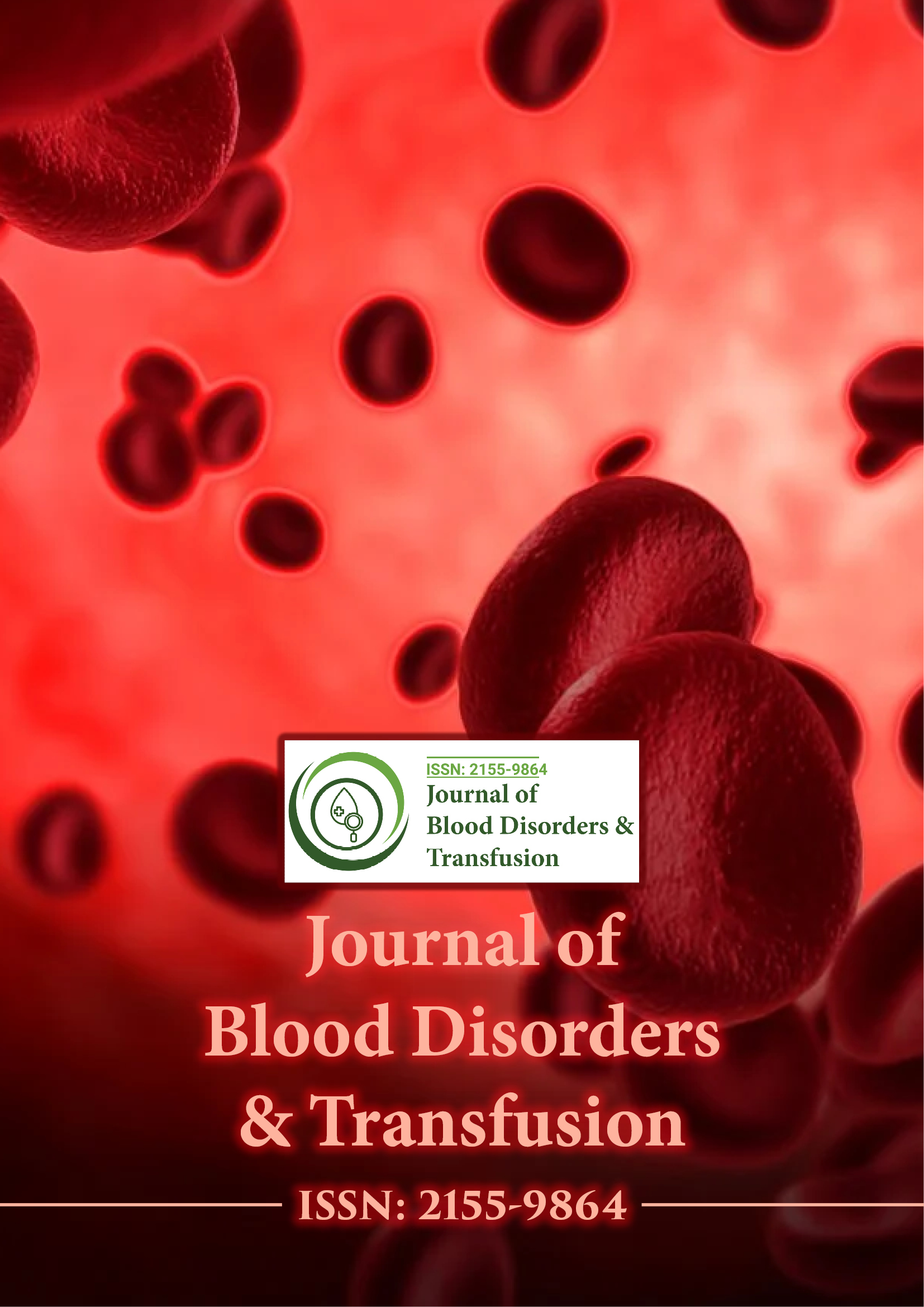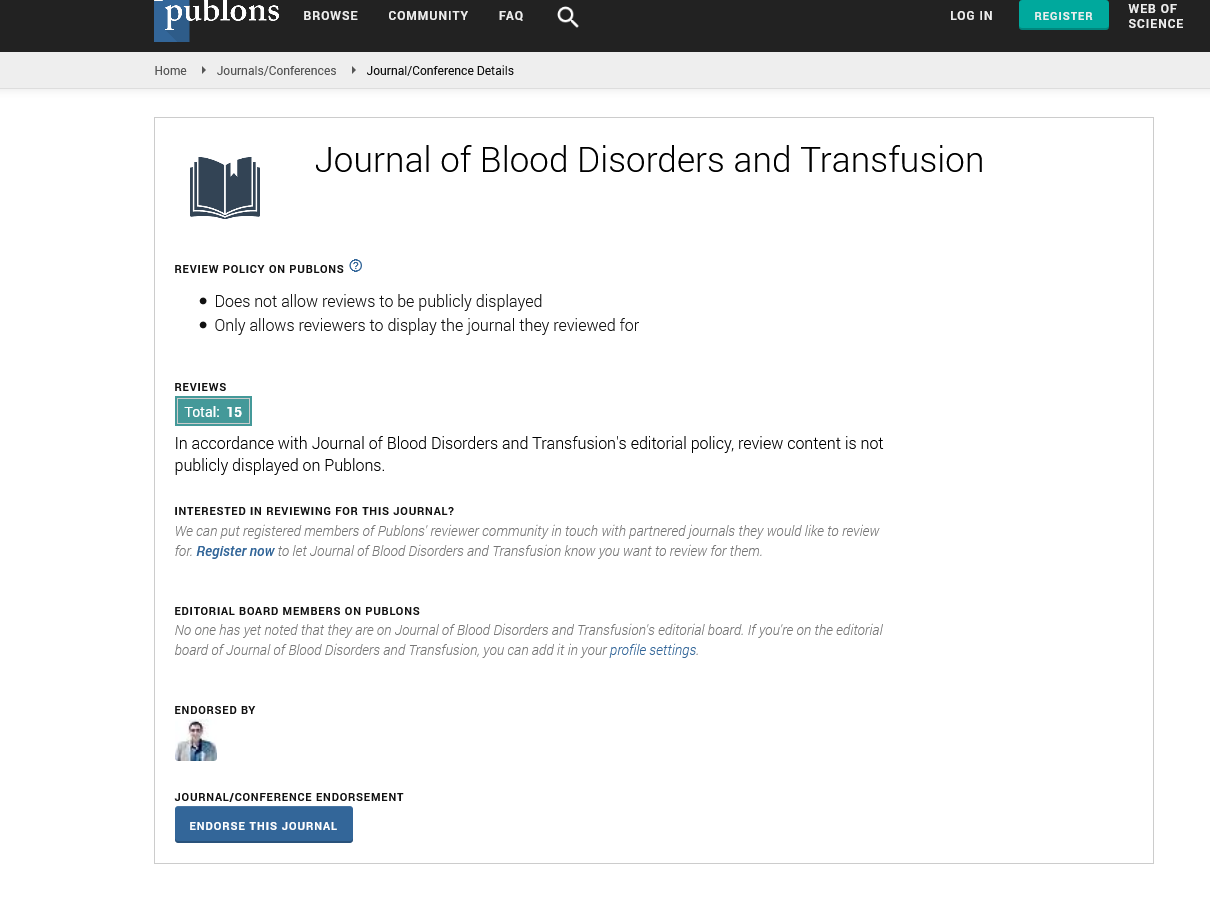Indexed In
- Open J Gate
- Genamics JournalSeek
- JournalTOCs
- Ulrich's Periodicals Directory
- RefSeek
- Hamdard University
- EBSCO A-Z
- OCLC- WorldCat
- Proquest Summons
- Publons
- Geneva Foundation for Medical Education and Research
- Euro Pub
- Google Scholar
Useful Links
Share This Page
Journal Flyer

Open Access Journals
- Agri and Aquaculture
- Biochemistry
- Bioinformatics & Systems Biology
- Business & Management
- Chemistry
- Clinical Sciences
- Engineering
- Food & Nutrition
- General Science
- Genetics & Molecular Biology
- Immunology & Microbiology
- Medical Sciences
- Neuroscience & Psychology
- Nursing & Health Care
- Pharmaceutical Sciences
Perspective - (2024) Volume 0, Issue 0
Risks and Benefits of Allogeneic Blood Transfusion in Preventing Surgical Site Infections
Yang Xiang*Received: 26-Jul-2024, Manuscript No. JBDT-24-26839; Editor assigned: 30-Jul-2024, Pre QC No. JBDT-24-26839 (PQ); Reviewed: 14-Aug-2024, QC No. JBDT-24-26839; Revised: 21-Aug-2024, Manuscript No. JBDT-24-26839 (R); Published: 29-Aug-2024, DOI: 10.4172/2155-9864.24.S10.050
Description
Allogeneic blood transfusion has become an essential component in modern surgical procedures. This practice involves the transfusion of blood components from a donor to a recipient. It is frequently used in various medical situations, especially during surgeries, to manage blood loss and ensure that the patient maintains adequate blood volume and hemoglobin levels. However, beyond merely sustaining blood volume, allogeneic blood transfusion plays a critical role in preventing Surgical Site Infections (SSIs). Allogeneic blood transfusion offers a vital advantage by supporting the immune system. During surgery, significant blood loss can compromise the patient’s immune response, making them more susceptible to infections. By replenishing lost blood, transfusion helps maintain immune function. A well-functioning immune system is essential for combating potential infectious agents that may enter the body during an operation. Additionally, allogeneic blood transfusion ensures that the body's oxygen-carrying capacity is maintained. Adequate oxygen delivery to tissues is essential for wound healing. Poor oxygenation can delay healing processes and increase the risk of infections at surgical sites.
Transfusing blood from allogeneic sources can help maintain optimal oxygen levels, thereby reducing the likelihood of SSIs. While the benefits are clear, it’s worth noting that allogeneic blood transfusion is not without risks. There is always a potential for adverse reactions or transmission of infections through transfused blood. Despite rigorous screening and testing protocols, these risks cannot be entirely eliminated.
Allogeneic blood transfusion plays a significant role in the surgical field, particularly in the management and prevention of Surgical Site Infections (SSIs). These infections are a common complication post-surgery, often leading to prolonged hospital stays and increased medical costs. Mechanisms of allogeneic blood transfusion. Allogeneic blood transfusion involves the transfusion of blood or blood components that have been collected from a donor. This procedure is essential in maintaining adequate blood volume and oxygenation levels during and after surgery. By providing the necessary blood components, it can help in stabilizing patients, thereby reducing the risk of SSIs.
Impact on immune response the relationship between allogeneic blood transfusion and the immune response is complex. While transfusions are essential for patient stability, they may also modulate the immune system. This modulation can either enhance the body's ability to fight off infections or, paradoxically, increase susceptibility to infections. Clinical evidence and guidelines recent studies have examined the impact of allogeneic blood transfusion on SSI rates. Evidence suggests that judicious use of transfusions, guided by clinical protocols, can mitigate some of the risks associated with SSIs. Guidelines recommend careful screening and matching of donor blood to reduce transfusion-related complications. Allogeneic blood transfusion also supports the immune function by supplying essential blood components that may be lost during surgery. These components, such as white blood cells and platelets, are vital for the immune system to effectively combat infections. Ensuring that the patient has sufficient immune resources can significantly lower the risk of developing surgical site infections.
Reducing Hemodynamic instability, which includes rapid changes in blood pressure and heart rate, can increase the risk of infections. Allogeneic blood transfusion stabilizes the patient’s hemodynamic status, ensuring that organs and tissues receive consistent blood flow. This stability helps in maintaining a robust immune defense, thereby preventing infections from taking hold. Enhancing tissue repair postoperative recovery often involves significant tissue repair, which can be compromised by poor blood supply. Allogeneic blood transfusion ensures that tissues receive the necessary nutrients and oxygen, facilitating faster and more efficient healing. Improved tissue repair reduces the window of vulnerability where infections could develop. In conclusion, allogeneic blood transfusion is an essential component in the prevention of surgical site infections. By maintaining oxygenation, supporting immune function, reducing hemodynamic instability, and enhancing tissue repair, allogeneic blood transfusion significantly contributes to successful surgical outcomes and patient recovery.
Risks and considerations of allogeneic blood transfusion is a common medical procedure used to replace lost blood during surgeries. It is important to understand the risks and considerations associated with this procedure to ensure patient safety. Infection risk one of the primary considerations of allogeneic blood transfusion is the potential risk of infection. Although blood screening processes are thorough, there remains a small risk of transmitting infections such as hepatitis B, hepatitis C, and HIV. This is why meticulous screening and testing of blood donors are essential to minimize these risks. Immune response allogeneic blood transfusions can sometimes trigger an immune response in the recipient. This can lead to complications such as Febrile Non-Hemolytic Transfusion Reactions (FNHTRs), where the patient's body reacts to the donor's white blood cells. More severe immune responses include Transfusion-Related Acute Lung Injury (TRALI) and Transfusion-Associated Graft-Versus-Host Disease (TA-GVHD). Allergic reactions patients may experience allergic reactions to allogeneic blood transfusion. These reactions can range from mild, such as itching and hives, to severe, including anaphylactic shock. It is important for healthcare providers to monitor patients closely during and after the transfusion to manage any adverse reactions promptly. Significant risk of allogeneic blood transfusion is the possibility of hemolytic reactions. These occur when the transfused blood is not compatible with the recipient's blood type, leading to the destruction of red blood cells. This can cause symptoms such as fever, chills, back pain, and dark urine. In severe cases, hemolytic reactions can result in kidney failure and death.
Citation: Xiang Y (2024). Risks and Benefits of Allogeneic Blood Transfusion in Preventing Surgical Site Infections. J Blood Disord Transfus. S10:050.
Copyright: © 2024 Xiang Y. This is an open-access article distributed under the terms of the Creative Commons Attribution License, which permits unrestricted use, distribution, and reproduction in any medium, provided the original author and source are credited.

